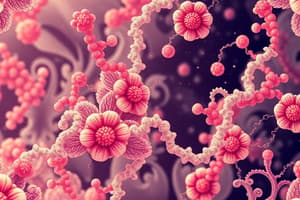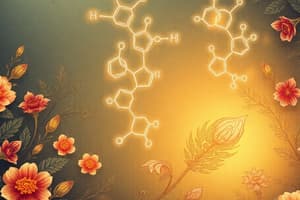Podcast
Questions and Answers
What type of reaction is the reaction of water with an alkene to produce an alcohol?
What type of reaction is the reaction of water with an alkene to produce an alcohol?
- Condensation
- Saponification
- Combustion
- Addition (correct)
In the preparation of an ester, what are the organic starting materials typically required?
In the preparation of an ester, what are the organic starting materials typically required?
- An acid and alcohol (correct)
- Alkane and aldehyde
- A ketone and alcohol
- Water and oxygen
What is the product of a typical esterification reaction?
What is the product of a typical esterification reaction?
- Aldehyde
- Ester (correct)
- Alkyne
- Alcohol
What type of isomerism is shown when the compounds have different functional groups but the same molecular formula?
What type of isomerism is shown when the compounds have different functional groups but the same molecular formula?
How are short chain alkanes typically prepared?
How are short chain alkanes typically prepared?
What is required for the saponification of fats to proceed to completion?
What is required for the saponification of fats to proceed to completion?
What is the main characteristic of a condensation reaction?
What is the main characteristic of a condensation reaction?
What is the result of a saponification reaction?
What is the result of a saponification reaction?
What functional groups are produced when esters undergo saponification?
What functional groups are produced when esters undergo saponification?
What is essential to make a chemical reaction feasible?
What is essential to make a chemical reaction feasible?
How are organic compounds typically synthesized?
How are organic compounds typically synthesized?
What are some common ways to prepare organic compounds?
What are some common ways to prepare organic compounds?
Which type of reaction involves a substance reacting with oxygen gas to release energy in the form of light and heat?
Which type of reaction involves a substance reacting with oxygen gas to release energy in the form of light and heat?
What is a notable example of a combustion reaction mentioned in the text?
What is a notable example of a combustion reaction mentioned in the text?
In combustion reactions, which reactant must be involved?
In combustion reactions, which reactant must be involved?
What is the outcome of fuels rapidly reacting with oxygen in combustion reactions?
What is the outcome of fuels rapidly reacting with oxygen in combustion reactions?
Which type of reaction involves the conversion of multiple bonds into other functional groups?
Which type of reaction involves the conversion of multiple bonds into other functional groups?
Which of the following elements can be attached or added to carbons involved in multiple bonds in organic compounds?
Which of the following elements can be attached or added to carbons involved in multiple bonds in organic compounds?
Study Notes
Condensation Reactions
- A condensation reaction occurs when two or more molecules combine to form a larger molecule, with the simultaneous loss of a small molecule such as water and the formation of a new bond.
- Water is lost as a product, and a new oxygen-carbon bond is formed.
- Examples of condensation reactions include reactions 5 and 6.
Saponification Reactions
- Saponification reaction occurs when a fat, oil, or lipid is cleaved and converted into soap and alcohol by the action of heat, water, and a base.
- Fats are typically in the form of esters.
- When esters undergo saponification, carboxylate (soap) and an alcohol (glycerol) functional groups are produced.
Preparation of Selected Organic Compounds
- Organic compounds are synthesized from other groups of organic compounds.
- Two or more organic compounds react to form a new organic compound with characteristic properties.
- Heat, temperature, pressure, acids, bases, and water are essentials needed to make a chemical reaction feasible.
- Examples of preparation routes include:
- Preparation of Alkanes
Isomerism
- Functional isomerism occurs when different compounds are formed due to different arrangements of their atoms leading to different functional groups.
- Functional isomers have entirely different properties.
- Examples of positional isomerism include:
- C2H6O
- C3H6O
- C2H4O2
Simple Reactions of Organic Compounds
- Combustion Reactions:
- Occur when a substance reacts with oxygen gas, releasing energy in the form of light and heat.
- Must involve O2 or oxygen gas as one reactant.
- Examples include the combustion of organic fuels, such as coal, high molecular weight hydrocarbons, methane, propane, and butane.
- Addition Reactions:
- Multiple bonds, such as a double or a triple bond, can be converted into other functional groups.
- Elements such as hydrogen, halogens, compounds like water, and functional groups such as the hydroxyl group can be attached or added to one or both of the carbons involved in the multiple bond.
- Examples include reactions 2, 3, and 4.
Studying That Suits You
Use AI to generate personalized quizzes and flashcards to suit your learning preferences.
Description
Test your knowledge on condensation reactions where molecules combine to form a larger molecule with the loss of a small molecule like water, and saponification reactions where fats are converted into soap and alcohol. Examples and mechanisms are covered in this quiz.




